Visitors as of 8/16/2021
Unless you make it a point to actively search for patterns-of-three, you may not even think to survey any internet or other search with an intent to identify how many and what kinds of three-patterned references are being used. The same goes for any number, symbol or illustration, however they may be arranged according to your respective interest. And if someone does take the time to point out a recurring pattern in your favorite subject, you may become defensive like a poet when someone points out some meaning that they themselves did not consciously intend to display or were aware of. Then again you may react by saying that there are other patterns as well and therefore the pattern(s) a given person is speaking of does not have a supposed dominant position and therefore nor main theme which to discern some greater value that a person did not or does not commonly hold. In short, there are multiple patterns which can be found, but overall, there appears to be a limitation and a central pattern which may occur more often than one or another to be pointed out. Most people... apparently, have to be shown the presence of a pattern, though some are well aware of one and may even illustrate the presence of a pattern that someone who is pointing out a pattern did not see.
For example, I may point out the recurrence of "threes" in different forms while another person may point out twos, five, sixes, sevens, etc., or some other pattern related to a given person's interest who does not itemize perceived patterns with numbers. Yes, I can overlook patterns that others see clearly. And yet, when the other patterns are made known and "translated" into a number reference, we see that there is a limitation as to the quantity and quality of numbers being used again and again. Basic patterns do exist and may even have their own underlying basic patterns themselves. Interestingly however, we do not see a frequent usage of numbers as one does when the Dewey decimal system in applied. In other words, for example, most favorite numbers appear to be whole numbers like 1, 2, 3... and other Natural numbers, while a few people may choose to prefer a decimal like 3.14 representing the notion of Pi... but this too is a pattern-of-three... or so we may initially define as such. We do not see the majority of people describing other than a simple Natural number even though the natural number may be in the tens, hundreds, thousands, or whatever. In other words, if a person has the favorite number of 111, 222, 333... or 666, or some other single digit, three-patterned ensemble, we do not see them using a fraction or a decimal accompaniment. Hence, we see a recurrence of a given pattern for human cognition. We need to be actively cognizant of this over time in order to determine whether there is a change in human cognition and what is (or may be) the causal factor or at least some causal link.
Many people are using a "three" reference in different ways in different subjects, just as others are consciously or unconsciously using twos, or sevens, or 13s, etc... Once you start to look for a given pattern you can in fact find such a pattern and may at times get so caught up in the search that you begin towards an inclination of seeing the pattern(s) where it may not actually exist except for in your own mind. For example, one may not consciously see how many of a given type of vehicle is on the road until one actively searches for them. The same goes for expressions, hairstyles, preferred foods, etc... And yes, time and place have a lot to do with the preference of some patterns. Yet, to find a pattern such as "threes" in multiple subject areas and have only a few claiming such a usage is based on spirituality or some sort of superstition, is rather idiotic. Just because a given numerical pattern occurs in religious texts and activities does not mean a religion owns that number. The same goes for any pattern found or used in any subject. The subject appears to be the vehicle of transport just like different life forms are the transportation devices used by DNA.
When I encounter the lack of the number three being used in a given instance, I must wonder why if it is so important, as one might consider it to be since it is used in different subjects which are otherwise defined as being serious, and not merely based on personal preference or judgment as one might conclude when one thinks of interpreting a religious text or Astrology occurrence. Again, Yes... you can find other patterns but when we put all the patterns together we notice the expression of a limitation, like the limitation of a triplet code in DNA and RNA, and the limitation of elements in the periodic table thereof. If we say that the usage of a given number pattern is arbitrary, then why is this arbitrariness so frequent and presents us with a recurring pattern? If we humans can use any numbers we want, why do we appear to insist upon using only a handful if all the subjects of our interest? If seven is so important as some claim, why aren't we on the seventh planet? Why doesn't DNA have some other than a triplet code? Why is particle physics replete with patterns-of-three? Then again, why haven't we humans developed a working plan to build ternay (trinary) computers? Why do Astronomers speak of Binary star groupings as a given repetition of reference, and not trinary star groupings? Indeed, something is forcing us to abide by... let us say... a code of limitations, and does not let our imaginations run as wild as we would think we are capable of, even when subjected to mind altering drugs or other experiences?
The many different examples of "threes" in different subjects is being viewed as a recurring phenomena of human cognitive activity. However, there are other patterns as well, but when all the patterns are catalogued, we can see a small assortment of frequently used patterns. Those ideas which do not conform to the routines of patterns which can be identified need to be catalogued as some type of anomaly and used as a reference which may include defining such occurrences as flukes, as aberrations, as intentional attempts by a person or group to appear to be different... if not better in some way such as more creative, more intelligent, etc... I am listing a very small handful of examples as a means to show how diverse the application of similar patterns can crop up, but nonetheless represent a standard that may be defined as due to a physiological, environmental, cultural or other influence. If, for example, patterns-of-three are due to an environmental influence and we take the time to note that there is an ongoing incremental deterioration of the environment (the Sun is burning out, the Earth's rotation is slowing, the Moon is receding), then we need to take stock of the present currency of standard cognitive patterns in order to detect whether or not changes in the environment are affecting changes in the types and frequencies of the standard cognitive patterns or there is a decided change due to adaptation which makes us overlook that our ideas are part of a larger process of rationalization as a means of attempting some semblance of a survivalist equilibrium.
There are recurring patterns of thought that humans are using to illustrate their perceptions of reality. Sometimes in singularities such as the concept of a single god in monotheism, or dualities/dichotomies, etc... such as in the yin-yang, nature/nurture, etc., formulas, or tripartite schemas, or quadripartite, quintuplet, etc... with a decided limitation to the quantity and quality of patterns being reused in different contexts with the language and symbols consistent with a given topic. I know this is occurring and so do many readers. However, what is escaping most of us is the socially acknowledged realization that when we are confronted by an idea, a theory, a supposition, a guess, a dream, or whatever... that does not conform to one or more of the recurring patterns, we are inclined to over-value them or under-value them... even to the point of dismissive ness. For example, while confronted by different theories of time, space, consciousness, and other phenomena claimed to be the preserve of physics discussions, the presentation of ideas as "universal models" or "mathematical models" or some other typical illustrative vernacular implying the presence of a blueprint or multiple blueprints which are thought to be pieces of a puzzle frequently referred to parts of a Grand Unified Theory (GUT) or Theory Of Everything (TOE)... (or whatever anatomical abbreviation one might conjure up); we are not devising a method of analysis for tracking such anomalous characters of thought which may well indicate fabrications which are too deviant to be a part of the universe the human reality can participate physically in. While this is not to say that human imagination may be as constricted as human physiology, ideas which do not admit to the conventions of patterns which recur on such a frequent basis as to present us with constants, must be held in suspect as variables which may do little else than distract us from creating the most useful orientations of reality as humanity is capable of utilizing.
Where is the value of an idea's pattern if it can be used for nothing more than entertainment? Hence, we need to label such ideas as having entertainment value but no applicable value under current human adaptations. Arguing that such anomalous or infrequent patterns may have value sometime, someday, in some place, is not weighty enough to make them into an accepted law to be pedaled as having more importance than they actually do. All too often we are confronted by ideas in physics, mathematics, script writing, poetry, art, music, dance, etc., that have no real value other than entertainment and distraction, but are given an over-valuation which drags human progress down. Granted that many "anomalous" ideas are said to have eventually provided us with some technology that is useful, but such ideas are not being looked at as exhibiting basic patterns. Instead, by labeling ideas as new, different, progressive, rebellious, etc., instead of identifying their underlying patterns, we confuse the issue of what is being meant as an anomaly. Labeling something as being different instead of looking at the basic underlying pattern(s) of the idea itself causes misidentification and misunderstanding of what I am describing. Regardless of the words and/or labels used to describe an idea, if the underlying pattern(s) differ from the commonality of those frequently used, we are thus confronted by a very real anomaly. For example, if all subjects characterize most of their ideas with patterns-of-two, three and/or four, and then we are confronted by someone who used the language and symbols of a given subject to describe a pattern such as 136874392, 34,11111, or whatever..., then we must make note of the perceived difference and ask if the person simply made it up to be different, or that there is an anomaly in nature, or whether the person made a mistake, or are others misinterpreting the idea because it too contains some internalized commonality which is being cloaked due to the method by which the value had been reached.
Nonetheless, it behooves us to recognize that certain patterns are recurring enough to suggest th existence of a fundamental character to human thought processing. Deviations from the... let us say... norm, may itself be a recurring pattern of deviation that is part of the overall standard of cognitive processing. By allowing for the existence of a deviation, we can use this idea to not only provide allowances of seemingly discrepancies, but allow for a means to persuade some thinkers to permit themselves to push the currency of standards into the realms of deviations so as to assume that present considerations are too restrictive... and than a more enlarged perception is obtainable if we permit ourselves to create suppositions for the possibility of a more embracing, or unified view. For example, the standard model of a truck in a given culture fills the truck bed up to the manufactured sides. Yet in another culture someone has devised a means to place boards or nets alongside the truck bed in order to increase the size of the payload to be carried. Whereas in the first culture the people did not think outside the conventional truck bed box, the second culture did. And then a third culture comes along and applies this truck bed enlargement idea to all subjects... though the subjects are manufactured by very strict academic standards which has created a production line of producing students to frame their thinking within the conventions of a parameter which is viewed as a standard operation procedure. However, whereas some "aberrant" private teaching schools have recognized the flaw in the typical thinking, they think only to enlarge the convention of the truck bed box by lengthening it, and not providing for a standard of deviation which provides for a means to heighten or created depth. Academia has stuck humanity in a rut, just as business, politics and religions have.
With respect to different cognitive patterns available for inclusion in a topic on cognitive models, I have limited the following examples to the values of two, three and four, though other values exist in conjunction with the 'three" such as the 5 and 8 in biology and chemistry. It should be further noted that in some cases where a two is used or mentioned, what we find is an underlying triple pattern and vice versa. In some instances I have encountered "embellishments" of values where a singularity is expressed as a multiplicity (such as two or three), and that a two-pattern can be (attemptedly) illustrated and labeled as a three, such as in the case of the so-called trigrams of the I-Ching:
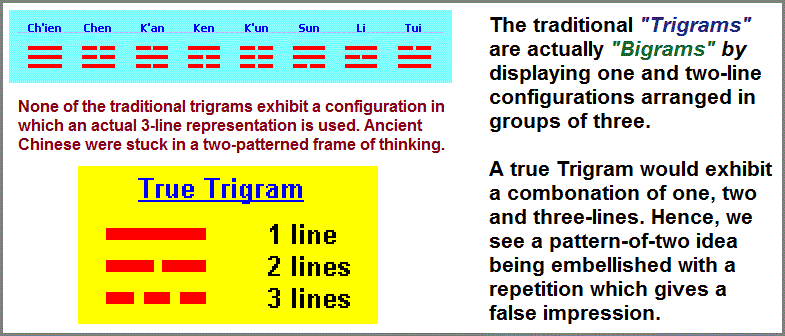
Another example of a perceived difference taking place where there is a question of two or three, is found in the following illustration:
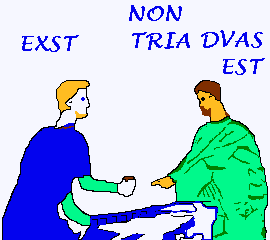 |
Roman dicers from a fresco at Pompeii, playing what is thought to be an early version of backgammon. The cartoon-like captions above their heads describe a disputed call: the man on the left cries, "I've won!" while the one on the right objects, claiming, "It's not a three, it's a two." Analogously, the two characters can be viewed as the right & left hemispheres of the brain. The right adamantly refuses to acknowledge the left's
claim to a 3 and insists that the "3" the left sees is actually a 2. If the overall purpose of the "game" (life) is to achieve a "3" and yet there is a
claim from some for a preponderance of "2" (with all its various guises), do we try to change the rules of the "game" or create a teaching methodology
which enables the distinctions of "2" and "3" to be made identifiable and useful from all vantage points? (Even if the purpose of the game is defined by
Earth-specific environmental circumstances.) The social problems created by an underlying 2 versus 3 contention has been going on for long enough... since
Pompeii anyway. Let's not leave a similar picture of us for future historians who find it beneath the rubble of an extinct civilization. |
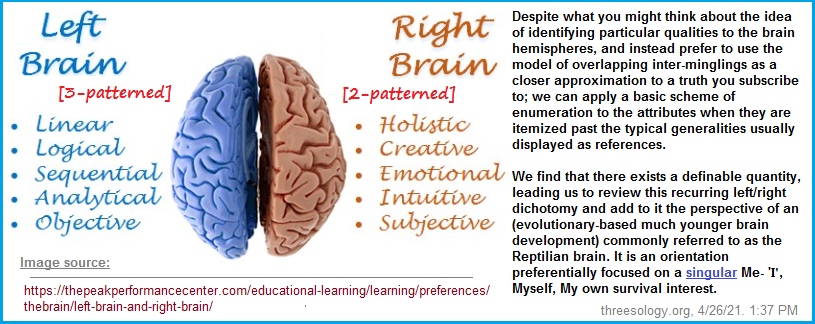
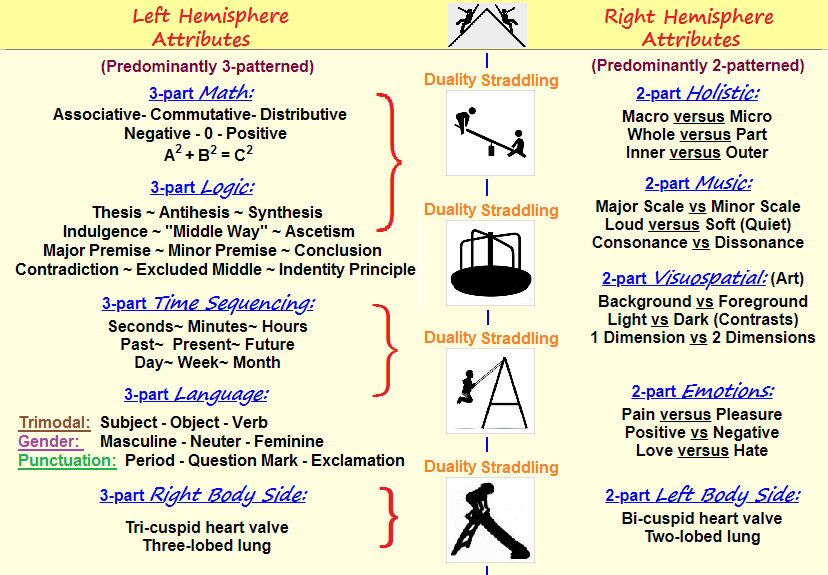
Threesology Research Journal (Home page)
- On the origin and evolution of the tripartite brain by Frank Hirth
Abstract
The many different nervous systems found in bilaterally symmetric animals may indicate that the tripartite brain appeared several times during the course of bilaterian evolution. However, comparative developmental genetic evidence in arthropods, annelids, urochordates, and vertebrates suggests that the development of a tripartite brain is orchestrated by conserved molecular mechanisms. Similarities in the underlying genetic programs do not necessarily reflect a common origin of structures. Nevertheless, 3 lines of evidence support a monophyletic origin of the tripartite brain and possibly also an elongated central nervous system (CNS): structural homology, character identity networks, and the functional equivalence of character identity genes. Monophyly of the brain also implies that the brain was secondarily reduced and lost multiple times during the course of evolution, leading to extant brainless bilaterians. The likelihood of secondary loss can be estimated by metazoan divergence times and through reconstructed cases such as limb loss in tetrapods or eye loss in fish. When scaled to molecular clock dates, monophyly of the tripartite brain indicates that existing brainless Bilateria had several hundred million years' time for the secondary modification and eventual loss of a primitive/ancestral brain and CNS. To corroborate this conjecture, ancestral character identity genes of living brainless Bilateria can be tested for their potential to substitute Drosophila or Mus homologs in tripartite brain development. (Copyright © 2010 S. Karger AG, Basel.)
- The Tripartite Influence model of body image and eating disturbance: a covariance structure modeling
investigation testing the mediational role of appearance comparison by Patricia van den Berg, J Kevin Thompson, Karen Obremski-Brandon, and Michael Coovert
Abstract
Recent theoretical approaches to the etiology of eating disorders and body image disturbances have begun to focus on multifactorial models. In the current study, the Tripartite Influence model was examined in a large sample of college females (ages 18-22). This model proposes that three primary core sources of influence--parents, peers and media--contribute to the development of body image and eating disturbances. Additionally, the model suggests that at least two factors mediate the relationship between influences and disturbance-appearance comparison and internalization of media information. In this study, appearance comparison was examined as a mediational link between peer, family and media influence variables and the outcome disturbance measures of eating dysfunction and body image dissatisfaction. Covariance structure modeling (CSM) was used to test the proposed pathways. The results indicated that appearance comparison mediated the effects of family and media influences on body dissatisfaction, which in turn influenced restrictive and bulimic behaviors. In addition, peer influences had a direct influence on restriction. Perfectionism was hypothesized to relate to body dissatisfaction, but was in fact found to influence appearance comparison. The findings were limited by the necessity of several modifications to the originally proposed models, yet offer replication and extension of previous work with appearance comparison and support for further testing of the Tripartite Influence model. (Copyright 2002 Elsevier Science Inc.)
- Tripartite Xoonosis Guide
The Tripartite Zoonoses Guide (TZG) has been jointly developed by the FAO, OIE, and WHO to support countries in taking a multisectoral, One Health approach to address zoonotic diseases. It provides principles, best practices and options to assist countries in achieving sustainable and functional collaboration at the human-animal-environment interface. Taking a multisectoral, One Health approach is necessary to address complex health threats at the human-animal-environment interface, such as rabies, zoonotic influenza, anthrax, and Rift Valley fever. Such zoonotic diseases continue to have major impacts on health, livelihoods, and economies, and cannot be effectively addressed by one sector alone. By using the TZG and its associated operational tools, countries can build or strengthen their national capacities in:

Options for monitoring and evaluating the impact of these activities are included allowing countries to make improvements in their zoonotic disease frameworks, strategies and policies. Moreover, taking the One Health approach presented in the TZG helps countries to make the best use of limited resources and reduces indirect societal losses, such as impacts on livelihoods of small producers, poor nutrition, and restriction of trade and tourism. By working together and collaboratively, our global health systems are improved in a sustainable way ensuring an efficient prevention of the global health risks.
- Sigmund Freud’s Tripartite Theory of Mind (From the Lecture Series:
Redefinining Reality: The Intellectual Implications of Modern Science)
A short review/discussion about the Id, Ego, Superego.
- Plant intelligence and attention by Michael Marder
Abstract
This article applies the phenomenological model of attention to plant monitoring of environmental stimuli and signal perception. Three complementary definitions of attention as selectivity, modulation and perdurance are explained with reference to plant signaling and behaviors, including foraging, ramet placement and abiotic stress communication. Elements of animal and human attentive attitudes are compared with plant attention at the levels of cognitive focus, context and margin. It is argued that the concept of attention holds the potential of becoming a cornerstone of plant intelligence studies.
Introduction
Studies of plant intelligence have tended to concentrate on memory as a benchmark of intelligent behavior.1,2 Although memory has a bearing on all three modalities of time, including a remembered past event, the present of storage and the possibility of future retrieval, it is a marker of intelligence heavily biased toward the past. On the other hand, attention is a feature of intelligent conduct in the present, whereby an organism selectively responds to ever-shifting stimuli in a way that allows it to maintain adequate levels of adaptation to its environment. Before processing, evaluating and communicating information, plants must first attend to—or take note of—the bits that are relevant to their optimal growth and development. Attention's chronological precedence is matched in importance by its scope, insofar as attention accompanies all other components of intelligent conduct.
- Disturbances of Time Consciousness> From a Phenomenological and a
Neuroscientific Perspective by Kai Vogeley, Christian Kupke
Abstract
The subjective experience of time is a fundamental constituent of human consciousness and can be disturbed under conditions of mental disorders such as schizophrenia or affective disorders. Besides the scientific domain of psychiatry, time consciousness is a topic that has been extensively studied both by theoretical philosophy and cognitive neuroscience. It can be shown that both approaches exemplified by the philosophical analysis of time consciousness (Husserl) and the neuroscientific theory of cross-temporal contingencies (binding of cognitive processes over time) as the neurophysiological basis of human consciousness implemented in the prefrontal cortex (Fuster) converge in 2 respects.
(1) Firstly, a tripartite conception of consciousness divides human cognition in 3 different temporal domains comprising retention, presentation, and protention (Husserl) and the past, the present, and the future corresponding to working memory, interference control, and preparatory set (Fuster).
(2) Secondly, both concepts refer to the present as an extended duration that integrates information from the recent past and the future. We propose that the integration of phenomenological and neuroscientific approaches can stimulate the development of enriched pathophysiological concepts of mental disorders. This approach appears to be particularly fruitful with respect to schizophrenia that is interpreted as a structural disturbance of time consciousness.
- Introduction to Consciousness
conscious, preconscious, and unconscious; A history of A History of Theories of Consciousness; (yet no reference to insanity, sanity, and super-sanity)
-
A Tripartite Theory of Consciousness and Mind: the Neural-Menton Conjunction Hypotesis by Richard P. Shank
Abstract
In this paper we present a theory about the fundamental nature of consciousness and mind. The theory draws upon concepts from three sources, the Writings of Emanuel Swedenborg, modern neuroscience, and the Standard Model theory of particle physics. A central hypothesis of the theory is the existence of a theoretical particle, termed menton, which functions as a force carrier particle. Through the principles of correspon- dence and influx, a menton is functionally comparable to a photon. How- ever, rather than being assimilated into a recipient electron and thereby adding kinetic energy to the electron, a menton is postulated to conjoin with a recipient electromagnetic field generated by a specific type of neural network within the brain, and thereby add mental energy that confers consciousness or another form of mental activity. The postulated source of mentons is the spiritual sun.
- A Unified Approach to Human Consciousness
(Updating Freud's Topographical and Structural Models) by Gregg Henriques Ph.D.
A recent OpEd piece reminded me how muddled the concept of human consciousness can be*. It also reminded me that we need an approach that blends the best of both psychology and philosophy. Careful attention must be paid to complicated issues of definitions and word meaning, conceptual analysis, and metaphysical claims about reality (things that philosophers tend to be good at). And we also need to consider the everyday dynamics of conscious experience and human behavior, the empirical research literature, and various clinical presentations (things that psychologists tend to be good at). The unified approach integrates both psychology and philosophy to offer up a modern, integrative approach to human consciousness.
(H.O.B. note: This unification is a... 1 + 1 = 3 equation.) - Universal Tripartite Entanglement in One-Dimensional Many-Body Systems by
Yijian Zou, Karthik Siva, Tomohiro Soejima, Roger S. K. Mong, and Michael P. Zaletel
Abstract
Motivated by conjectures in holography relating the entanglement of purification and reflected entropy to the entanglement wedge cross section, we introduce two related non-negative measures of tripartite entanglement g and ℎ. We prove structure theorems which show that states with nonzero g or ℎ have nontrivial tripartite entanglement. We then establish that in one dimension these tripartite entanglement measures are universal quantities that depend only on the emergent low-energy theory. For a gapped system, we argue that either g ≠ 0 and ℎ = 0 or g = ℎ = 0, depending on whether the ground state has long-range order. For a critical system, we develop a numerical algorithm for computing g and ℎ from a lattice model. We compute g and ℎ for various CFTs (Conhformational Force Theories) and show that ℎ depends only on the central charge whereas g depends on the whole operator content.
- The Significance of a Bipartite/ Tripartite Division of the Psyche by Harrington, Tiffany
Abstract
Both Plato and Aristotle divide the soul into a distinct number of parts; Plato opts for a tripartite division, while Aristotle opts for a bipartite division. In most of his works, Plato defends a tripartite division of the soul, for example, in the Republic, Phaedrus, Apology, etc. dividing it into the appetitive, spirited and rational parts of the soul; however, in certain works, such as The Timaeus, a bipartite division is discussed, although he never abandons the tripartite division. Plato’s division of the soul is mainly developed in the context of discussions of politics and corresponds to his ideal state, in which there are three kinds of citizens. Aristotle, on the other hand, defends a bipartite division of the soul, dividing it into the rational and the irrational. The motive for dividing the soul into a bipartite or tripartite division is partly political and to explain human behavior, motivations or character types. I will argue that both Plato and Aristotle’s division of the soul agree that there are at least two, parts of the soul, namely, the rational and irrational; however, Aristotle’s division is superior because it is a simpler, more elegant version of Plato’s.
H.O.B. Note: Was the desription of the soul (in ancient times) governed solely by a political motivation, or did there exist a more fundamental influence and humans merely decided to adopt the notion of a political influence which distracts recognizning a mure fundamental influence?
- Is Man Tripartite or Bipartite? by Tim Staples
Televangelist and Founder and President of Charis Bible College, Andrew Wommack, has said: "The most important revelation I have ever received is the understanding that we were created by God with three distinct parts: spirit, soul, and body." This idea of man as essentially “tripartite” verses the Catholic and biblical notion of man as a body/soul composite is a rather common misconception among Evangelicals and Pentecostals. They may not go as far as Mr. Wommack and say this is “the most important revelation” they have ever received, but they will be quick to defend their position nonetheless...
- Spain: From Tripartite to Bipartite Pacts by
Oscar Molina and Martin Rhodes
Abstract
This chapter on Spain follows the general argument of the book in rejecting the explanatory capacity of single-variable analyses. The history of social pacts in Spain is one of early success in the 1980s, when broad or encompassing tripartite social pacts were abandoned, failures in the late 1980s and early 1990s, and a gradual institutional consolidation of peak concertation and bipartite pacting after 1997. This irregular pattern poses numerous challenges to scholars interested in social pact emergence and institutionalization. In explaining the Spanish experience, political and organizational factors-including government weakness and relations between and within the unions-are critical for explaining the timing and character of Spain's social pact responses to the problem loads of unemployment and inflation, while utilitarian and power-distributive arguments are best suited for understanding the fluctuation of pacting over time and the more recent period of partial institutionalization.
- A New Species of Amsassia from the Ordovician of Korea and South China:
Paleobiological and Paleogeographical Significance by Mirinae LEE, Heeju PARK, Nguyen Viet TIEN, Suk-Joo CHOH, Robert J. ELIAS, Dong-Jin LEE
Abstract
A new species of the probable calcareous alga Amsassia, A. koreanensis, is recognized from the Duwibong Formation (Middle Ordovician, Darriwilian) of the Taebaeksan Basin in mid-eastern Korea. This is the first report of the genus from the Korean Peninsula, expanding its geographical range to the eastern Sino-Korean Block. The new species also occurs in the Xiazhen Formation (Upper Ordovician, Katian) at Zhuzhai in the South China Block. Amsassia koreanensis is the smallest species of this modular genus, having a maximum module diameter of 0.28 mm. Module increase is by bipartite, tripartite and quadripartite types of longitudinal axial fission, but unlike other species of the genus, quadripartite fission is common. The types of fission are comparable to those in some Tetradiida (now Prismostylales, florideophycean rhodophyte algae), although the processes of fission are different. The distribution of A. koreanensis further strengthens the biogeographical connection between the Sino-Korean and South China blocks, suggesting that these two paleocontinents were located closer together during the Middle to Late Ordovician than previously speculated.
H.O.B. note: Thie is an example of a three-part ensemble. It is a feature illustrated as 2, 3, 4 in other subjects. Three-part ensembles can have different collections of numerical values such as the statement "The Magical Number Seven, Plus or Minus Two: Some Limits on Our Capacity for Processing Information" which describes the three-part sequence of 5,7, 9, but is commonly overlooked. Other sequences can be 3-5-8, 2-4-6, or combonations, including higher or lower values as well as symbols, where numerical references may not be intended such a linear- circular- triangular.
- A Conditional Walk
Quadripartite Graph Based Personalized Recommendation Algorithm by Yiwen Zhang, Chenkun Zhang, Anju Yang, Chengrui Ji, Lihua Yue,
Abstract
[Objective] By mining the relation characteristics between users and items, or between users and categories, this Paper extracts user preferences to optimize recommendation effect. [Methods] This paper extracts user rating and items degree attribute, mines user preferences, and puts forward the walk condition of User-Item bipartite graph; The category-User-Project-Category quadripartite graph is established by mapping User-Item-Category tripartite graph to the User-Category bipartite graph. The personalized recommendation method for user preferences through items and categories is proposed. [Results] Choosing MovieLens ratings data set as the source data, respectively comparing the experimental difference based on bipartite graph, weighted bipartite graph, tripartite graph and quadripartite graph, the results show that the Precision rate, MAE, recall rate, and coverage have been respectively optimized with this proposed method. [Limitations] Due to Movielens lack of critical textual data of users for movies, it is hard to analyze user preferences through the semantic. [Conclusions] This research analyzed user preferences through user ratings and degree attribute, it can be determined that the recommendation effect of quadripartite graph based on conditional walk is great.
- Triple Symbol Meanings by Avia
Triple symbol meanings and the power of threes…it is a phenomenon that’s been around since ancient times in many cultures. As a result, lots of symbols and icons have been created to establish three-fold meanings. This article on triple symbol meanings offers a whole list: From the triquetra to the trefoil, you’ll find triple symbol meanings here. For countless reasons, the phenomenon of three is a very big deal. And when I say phenomenon, I really mean it. The evidence of trinities, triads and triples run rampant in a myriad of cultures and spiritual beliefs. From the Christian trinity to the Celtic triquetra…the power of three is epic and it’s rooted in our ancestral customs. Why does the number three demonstrate spiritual unity in such significant ways? Why not the number eight or twelve? Well, I have a few theories. Namely, the number three — from a numerological perspective — packs a powerful punch.
The number three is all about balance. But not just any balance…it’s evolved. Before three came along, there was number two. It’s important to recognize this because two is the building block for three (and triple symbol meanings). Two is the ultimate expression of balance. Every number has a core meaning. Three is about evolutionary unity. It takes the balance established by the number two, then brings it together to create something beautiful. What I am saying here is three is the manifestation of number two being developed…obtaining balance and then finding a new life or new structure within that balance. Three takes a triad of influences and energies and constructs them into a glorious balance. That balance works. It works on so many different levels. Here are some examples of how trinities work from cultures around the world…..
H.O.B. note: Please don't get sucked into the language of religion for defining the threes phenomena. Religion already tries to stake a claim on the concepts of morality, god and what is meant by evility. (Evilness). By using the word "spirituality" applied to the threes phenomena, religion tries to own this recurrence of human conceptualization as well.
- A Phenomenological approach to Artistic Intention
Introductions
THE APPROACH IS TRIPARTITE, each part a stage transcending its predecessor:
- artistic intention as the matter-of-fact ground of art, in the same way in which, as Husserl describes it, the "foundation of naive-objectivistic science" is something taken for granted;
- the subjectivization of the perception of art through the deliberate introduction of a systematic doubt of the presumably self-evident objectivity of its ground—the doubt is designed to counteract the self-evidence—issuing in a phenomenological reduction of art, which, while it complicates the occupation of creating it with a preoccupation with its origin—at times the two exist in ironic interrelation, as in Duchamp—forces "the entrance" to a radical consciousness of art, to a critical consciousness of its foundation;
- the reviewing, under the auspices of the phenomenological epoché of artistic intention as "that ultimate originality which, once apparent, apodictically masters the will" to create art. The naiveté of the Dadas, the frustrations of Max Kozloff in his essay on "Critical Schizophrenia and the Intentionalist Method," and the hybris of Barnett Newman will serve as exemplars of each stage.
- Almost all triangle-free triple systems are tripartite by József Balogh
and Dhruv Mubayi
Abstract
A triangle in a triple system is a collection of three edges isomorphic to {123, 124, 345}. A triple system is triangle-free if it contains no three edges forming a triangle. It is tripartite if it has a vertex partition into three parts such that every edge has exactly one point in each part. It is easy to see that every tripartite triple system is triangle-free. We prove that almost all triangle-free triple systems with vertex set [n] are tripartite. Our proof uses the hypergraph regularity lemma of Frankl and Rödl, and a stabilitytheorem for triangle-free triple systems due to Keevash and the second author.
- THE TRIPARTITE DIVISION OF EDUCATION (1896)
THE tripartite division of education is of ancient date and wide currency. It is found in the writings of Plato and Aristotle, and was practically carried out in the schools of both Athens and Rome. Comenius, who was perhaps the first modern writer to work out an articulated systems of schools, made four divisions, including the school of infancy or the mother's lap;' and since his time the threefold scheme, not now counting the school of infancy, has become established in all progressive countries. These facts point to the conclusion that the tripartite scheme has at least been found convenient; and also raise the question of the basis on which it rests. Of course the divisions actually worked out in different times and places differ widely in them-selves...
- he tripartite model of perfectionism: Evidence from research in sport and dance. by John K. Gotwals
Abstract
The purpose of this chapter is to examine the degree to which the model’s contentions have been reproduced in research on perfectionism in sport and dance. There are four primary sections to the chapter. The first presents the foundations of the tripartite model. The second evaluates the degree to which research findings from sport and dance reproduce the tripartite model’s contentions and, as a result, support or challenge the model. The third section discusses methodological issues that, based on the previous review, may influence the degree to which research findings from sport and dance support or challenge the tripartite model. The final section presents directions that future research can take to advance understanding of the degree to which the tripartite model accurately captures perfectionism among athletes, dancers, and exercisers. (PsycInfo Database Record (c) 2020 APA, all rights reserved)
- Ruling out bipartite nonsignaling nonlocal models for tripartite correlations
by Peter Bierhorst
Abstract
Many three-party correlations, including some that are commonly described as genuinely tripartite nonlocal, can be simulated by a network of underlying subsystems that display only bipartite nonsignaling nonlocal behavior. Quantum mechanics predicts three-party correlations that admit no such simulation, suggesting there are versions of nonlocality in nature transcending the phenomenon of bipartite nonsignaling nonlocality. This paper introduces a rigorous framework for analyzing tripartite correlations that can be simulated by bipartite-only networks. We confirm that expected properties of so-obtained correlations, such as no-signaling, indeed hold, and show how to use the framework to derive Bell-inequality-type constraints on these correlations that can be robustly violated by tripartite quantum systems. In particular, we use this framework to rederive a version of one such constraint previously described in a paper of Chao and Reichardt, Test to separate quantum theory from non-signaling theories [arXiv:1706.02008 (2017)].
- Tripartite mutualisms as models for understanding plant-microbial interactions by Michelle E Afkhami,
Brianna K Almeid, Damian J Hernandez, Kasey N Kiesewetter, Daniel P Revillin
Abstract
All plants host diverse microbial assemblages that shape plant health, productivity, and function. While some microbial effects are attributable to particular symbionts, interactions among plant-associated microbes can nonadditively affect plant fitness and traits in ways that cannot be predicted from pairwise interactions. Recent research into tripartite plant-microbe mutualisms has provided crucial insight into this nonadditivity and the mechanisms underlying plant interactions with multiple microbes. Here, we discuss how interactions among microbial mutualists affect plant performance, highlight consequences of biotic and abiotic context-dependency for nonadditive outcomes, and summarize burgeoning efforts to determine the molecular bases of how plants regulate establishment, resource exchange, and maintenance of tripartite interactions. We conclude with four goals for future tripartite studies that will advance our overall understanding of complex plant-microbial interactions. (Copyright © 2020 Elsevier Ltd. All rights reserved)
- The ecology of movement and behaviour: a saturated tripartite network for describing
animal contacts by Kezia Manlove, Christina Aiello, Pratha Sah, Bree Cummins, Peter J. Hudson and Paul C. Cross
Abstract
Ecologists regularly use animal contact networks to describe interactions underlying pathogen transmission, gene flow, and information transfer. However, empirical descriptions of contact often overlook some features of individual movement, and decisions about what kind of network to use in a particular setting are commonly ad hoc. Here, we relate individual movement trajectories to contact networks through a tripartite network model of individual, space, and time nodes. Most networks used in animal contact studies (e.g. individual association networks, home range overlap networks, and spatial networks) are simplifications of this tripartite model. The tripartite structure can incorporate a broad suite of alternative ecological metrics like home range sizes and patch occupancy patterns into inferences about contact network metrics such as modularity and degree distribution. We demonstrate the model's utility with two simulation studies using alternative forms of ecological data to constrain the tripartite network's structure and inform expectations about the harder-to-measure metrics related to contact.
- Design of a tripartite network for the prediction of drug targets by Ryo Kunimoto, and Jürgen
Bajorath
Abstract
Drug-target networks have aided in many target prediction studies aiming at drug repurposing or the analysis of side effects. Conventional drug-target networks are bipartite. They contain two different types of nodes representing drugs and targets, respectively, and edges indicating pairwise drug-target interactions. In this work, we introduce a tripartite network consisting of drugs, other bioactive compounds, and targets from different sources. On the basis of analog relationships captured in the network and so-called neighbor targets of drugs, new drug targets can be inferred. The tripartite network was found to have a stable structure and simulated network growth was accompanied by a steady increase in assortativity, reflecting increasing correlation between degrees of connected nodes leading to even network connectivity. Local drug environments in the tripartite network typically contained neighbor targets and revealed interesting drug-compound-target relationships for further analysis. Candidate targets were prioritized. The tripartite network design extends standard drug-target networks and provides additional opportunities for drug target prediction.
- Wikipedia: Soul
Trichotomy of the soul
Augustine (354-430), one of western Christianity's most influential early Christian thinkers, described the soul as "a special substance, endowed with reason, adapted to rule the body". Some Christians espouse a trichotomic view of humans, which characterizes humans as consisting of a body (soma), soul (psyche), and spirit (pneuma).[13] However, the majority of modern Bible scholars point out how the concepts of "spirit" and of "soul" are used interchangeably in many biblical passages, and so hold to dichotomy: the view that each human comprises a body and a soul. Paul said that the "body wars against" the soul, "For the word of God is living and active and sharper than any two-edged sword, and piercing as far as the division of soul and spirit" (Heb 4:12 NASB), and that "I buffet my body", to keep it under control.
Socrates and Plato
Drawing on the words of his teacher Socrates, Plato considered the psyche to be the essence of a person, being that which decides how we behave. He considered this essence to be an incorporeal, eternal occupant of our being. Plato said that even after death, the soul exists and is able to think. He believed that as bodies die, the soul is continually reborn (metempsychosis) in subsequent bodies. However, Aristotle believed that only one part of the soul was immortal, namely the intellect (logos). The Platonic soul consists of three parts (reason- spirit- appetite):
- the logos, or logistikon (mind, nous, or reason)... logos is located in the head, is related to reason and regulates the other part.
- the thymos, or thumetikon (emotion, spiritedness, or masculine)... thymos is located near the chest region and is related to anger.
- the eros, or epithumetikon (appetitive, desire, or feminine)... eros is located in the stomach and is related to one's desires.
Plato also compares the three parts of the soul or psyche to a societal caste system. According to Plato's theory, the three-part soul is essentially the same thing as a state's class system because, to function well, each part must contribute so that the whole functions well. Logos keeps the other functions of the soul regulated. In Plato's The Republic, Plato divides his just society into three classes: the producers, the auxiliaries, and the guardians. The auxiliaries are the warriors, responsible for defending the city from invaders, and for keeping the peace at home. They must enforce the convictions of the guardians, and ensure that the producers obey.
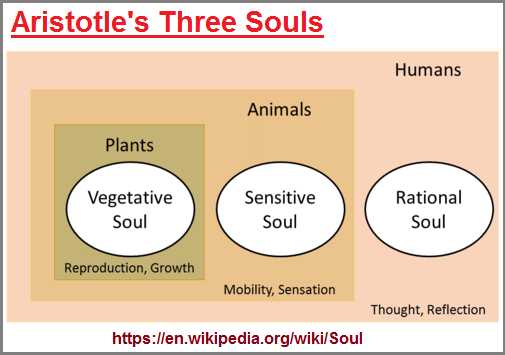
- The Triplet Code From First Principles by Edward N.
trifonov
Abstract
Temporal order ("chronology") of appearance of amino acids and their respective codons on evolutionary scene is reconstructed. A consensus chronology of amino acids is built on the basis of 60 different criteria each offering certain temporal order. After several steps of filtering the chronology vectors are averaged resulting in the consensus order: G, A, D, V, P, S, E, (L, T), R, (I, Q, N), H, K, C, F, Y, M, W. It reveals two important features: the amino acids synthesized in imitation experiments of S. Miller appeared first, while the amino acids associated with codon capture events came last. The reconstruction of codon chronology is based on the above consensus temporal order of amino acids, supplemented by the stability and complementarity rules first suggested by M. Eigen and P. Schuster, and on the earlier established processivity rule. At no point in the reconstruction the consensus amino-acid chronology was in conflict with these three rules. The derived genealogy of all 64 codons suggested several important predictions that are confirmed. The reconstruction of the origin and evolutionary history of the triplet code becomes, thus, a powerful research tool for molecular evolution studies, especially in its early stages.
- Why Did the Genetic Code of All Life
on Earth Suddenly Stop Evolving? by Sarah Emerson
Around 3,000 million years ago, something stopped the genetic code from growing.
ll life on Earth exists thanks to a universal genetic code. This biological rulebook tells our cells how DNA should be translated into life-supporting proteins, without which we couldn't survive. Even though the genetic code commands a seemingly immeasurable number of organisms, it also binds us all together as descendents of a shared ancestor—a lingua franca for life. Yet for all of its diverse and essential properties, the genetic code is static. For some reason unknown to scientists, approximately 3 billion years ago it simply stopped growing. Instead of expanding to encode new combinations of amino acids, and potentially new life, it stagnated at its current size and function. But a new study published today in the journal Science Advances offers an explanation for the genetic code's mysterious evolutionary limit...
- Why Not Ternary Computers? by David Scott Brown and reviewed by Kuntal Chakraborty
Reference commentary to binary, trinary (ternary) and quaternary computers.
- Deleuze's Three Syntheses Go to Hollywood: The Tripartite Cinema of Time Travel, Many
Worlds and Altered States by David Deamer
Abstract
What is called “time travel” cinema is but one aspect in a tripartite series of interweaving modes of disjunctive narration which is also – simultaneously – a cinema of "many worlds" and "altered states". Exploiting Gilles Deleuze's three syntheses of time, space, and consciousness from Difference and Repetition (1968) allows a conceptual development of these cinematic series through three popular Hollywood film cycles beginning with Planet of the Apes (Franklin J. Schaffner, 1968), The Terminator (James Cameron, 1984), and Back to the Future (Robert Zemeckis, 1985). In so doing, film and philosophy are deployed as two series which together create inexhaustible atemporal, aspatial, and ahuman disjunctions, ungrounding everyday spatio-temporal identities, and affirming productive images of cinematic thought.
Although the three elements may playfully circulate, it is tempting to make each one correspond to an aspect [...] as if the wheel were to stop three times in different fashions. (Deleuze, 2004b, p. 264)
To purloin a sentence from the very beginning of Gilles Deleuze's Cinema books (2001; 2002), this article "is a taxonomy, an attempt at the classification of images and signs" (Deleuze, 2002, p. xiv). The aim is to produce a taxonomy of "time travel" cinema through Deleuze's three syntheses from Difference and Repetition (2004a). The coordinates of this article are thus plotted by way of two little deviances. In the first place, there is the mobilisation of Deleuze's Difference and Repetition for an investigation of the cinema. So, the first deviancy is in not starting with the movement-images and time-images of Deleuze's Cinema books for what is – undeniably – some Deleuzian film theory. In the second place, this article explores three Hollywood time travel film cycles?–?beginning with Planet of the Apes (Franklin J. Schaffner, 1968), The Terminator (James Cameron, 1984), and Back to the Future (Robert Zemeckis, 1985) –through Deleuze's three syntheses. This second deviancy, accordingly, is in explicating what might be considered classical cinema in respect to Deleuze's "new image of thought" (Deleuze, 2004a, p. xv)...
- AGES AND AGES
To deal with the massive spans of time in this period, archaeologists traditionally divide prehistory into three main periods: the Stone, Bronze and Iron ages, named after the main technologies used at the time. And each period is subdivided – for example, the Stone Age into the Palaeolithic, Mesolithic and Neolithic (Old, Middle and New Stone Ages). These terms are seen as old-fashioned by some archaeolgists, who prefer to use more specific terms like Beaker period to reflect subtle developments in society, culture and technology. But the old, broad chronological divisions are still useful.
- Understanding the tripartite approach to Bayesian divergence time estimation by
Rachel C. M. Warnock and April M. Wright
Abstract
Placing evolutionary events in the context of geological time is a fundamental goal in paleobiology and macroevolution. In this article we describe the tripartite model used for Bayesian estimation of time calibrated phylogenetic trees. The model can be readily separated into its component models: the substitution model, the clock model and the tree model. We provide an overview of the most widely used models for each component and highlight the advantages of implementing the tripartite model within a Bayesian framework.
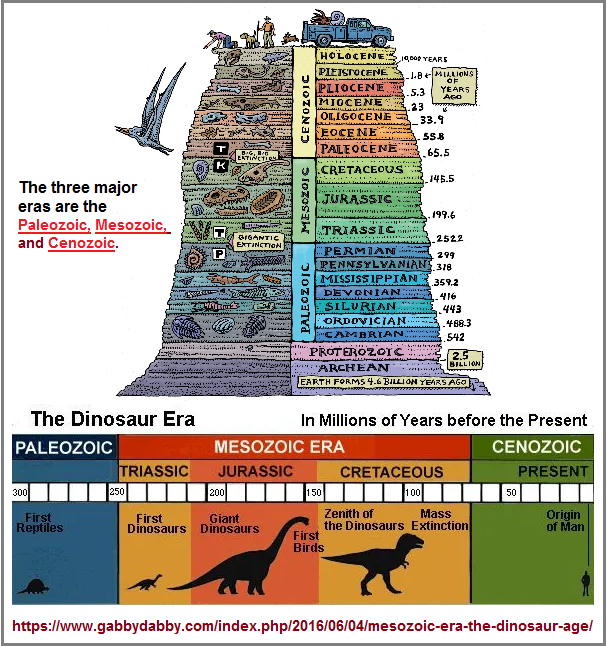
- Reconceptualisation of Architects’ Intentionality in Computational Form Generation:
A Tripartite Model by Duygu Tüntaş Karaman
Abstract
This paper attempts to create a theoretical framework to reconceptualise architects’ intentionality in computational form generation. Parallel to the increasing complexity of design problems and the increased realm of architects’ responsibility, the last two decades have shown that a vast amount of information can be managed and operated within the design process by using computational methods and associated technologies. This condition led to an expansion of the dominant mode in form computation that largely relies on data-driven forms as outcomes of pure calculations and rationalistic determinism. As an alternative, this study proposes a tripartite model as a basis to understand and assess design intentionality by unfolding and thereby reflecting on designers’ internalised processes. Initially defined in the field of computation, network and communication sciences for management and organisation of information, the proposed model – composed of centralised, partial and distributed approaches – is operational in responding to different forms and degrees of design intentionality within computational processes in architecture.
- The Metastability of the Double-Tripod Gait in Locust Locomotion by Eran Reches, Daniel
Knebel, Jan Rillich, Amir Ayali, and Baruch Barzel1
Summary
Insect locomotion represents a fundamental example of neuronal oscillating circuits generating different motor patterns or gaits by controlling their phase coordination. Walking gaits are assumed to represent stable states of the system, often modeled as coupled oscillators. This view is challenged, however, by recent experimental observations, in which in vitro locust preparations consistently converged to synchronous rhythms (all legs oscillating as one), a locomotive pattern never seen in vivo. To reconcile this inconsistency, we developed a modeling framework to capture the trade-off between the two competing mechanisms: the endogenous neuronal circuitry, expressed in vitro, and the feedback mechanisms from sensory and descending inputs, active only in vivo. We show that the ubiquitously observed double-tripod walking gait emerges precisely from this balance. The outcome is a short-lived meta-stable double-tripod gait, which transitions and alternates with stable idling, thus recovering the observed intermittent bouts of locomotion, typical of many insects' locomotion behavior.
- Sample records for alternating tripod gait
Climbing favours the tripod gait over alternative faster insect gaits by Ramdya, Pavan; Thandiackal, Robin; Cherney, Raphael; Asselborn, Thibault; Benton, Richard; Ijspeert, Auke Jan; Floreano, Dario
To escape danger or catch prey, running vertebrates rely on dynamic gaits with minimal ground contact. By contrast, most insects use a tripod gait that maintains at least three legs on the ground at any given time. One prevailing hypothesis for this difference in fast locomotor strategies is that tripod locomotion allows insects to rapidly navigate three-dimensional terrain. To test this, we computationally discovered fast locomotor gaits for a model based on Drosophila melanogaster. Indeed, the tripod gait emerges to the exclusion of many other possible gaits when optimizing fast upward climbing with leg adhesion. By contrast, novel two-legged bipod gaits are fastest on flat terrain without adhesion in the model and in a hexapod robot. Intriguingly, when adhesive leg structures in real Drosophila are covered, animals exhibit atypical bipod-like leg coordination. We propose that the requirement to climb vertical terrain may drive the prevalence of the tripod gait over faster alternative gaits with minimal ground contact.
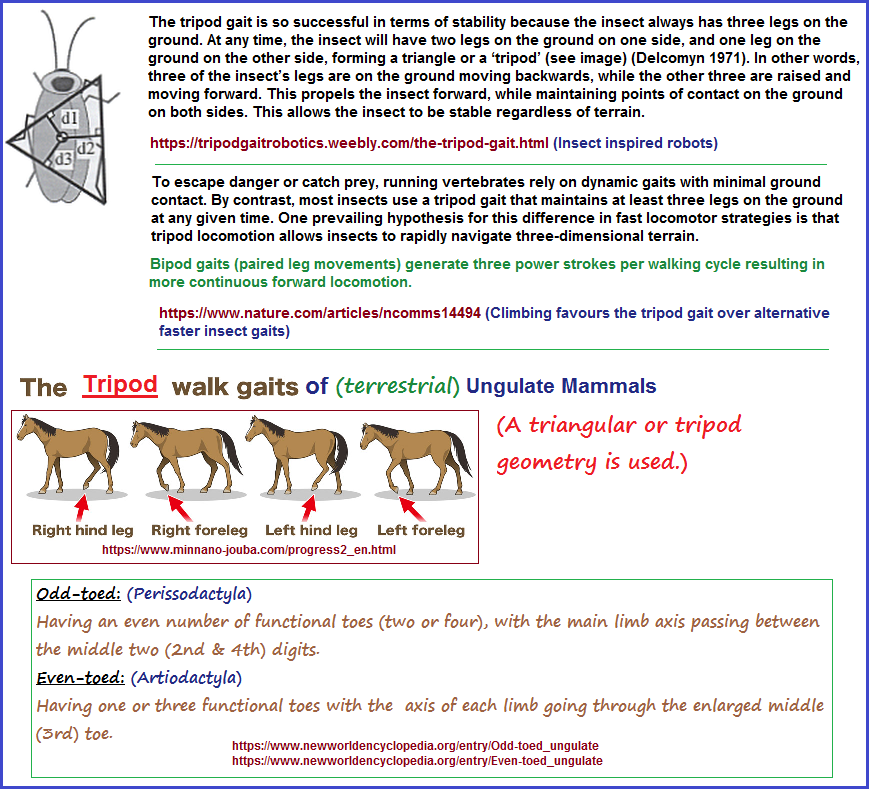
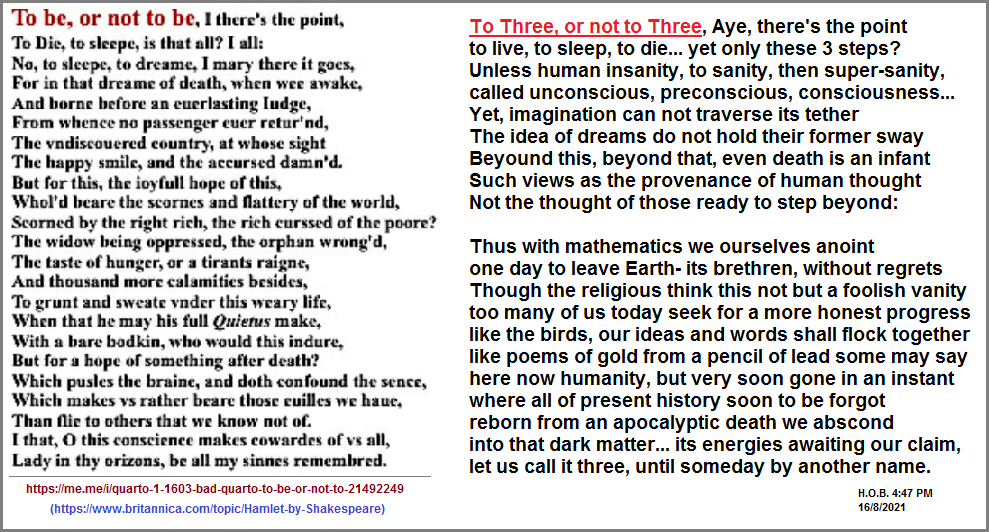
Date of Origination: Saturday, 14th August, 2021... 7:57:45 AM
Date of Initial Posting: Monday, 16th August, 2021... 5:25 PM